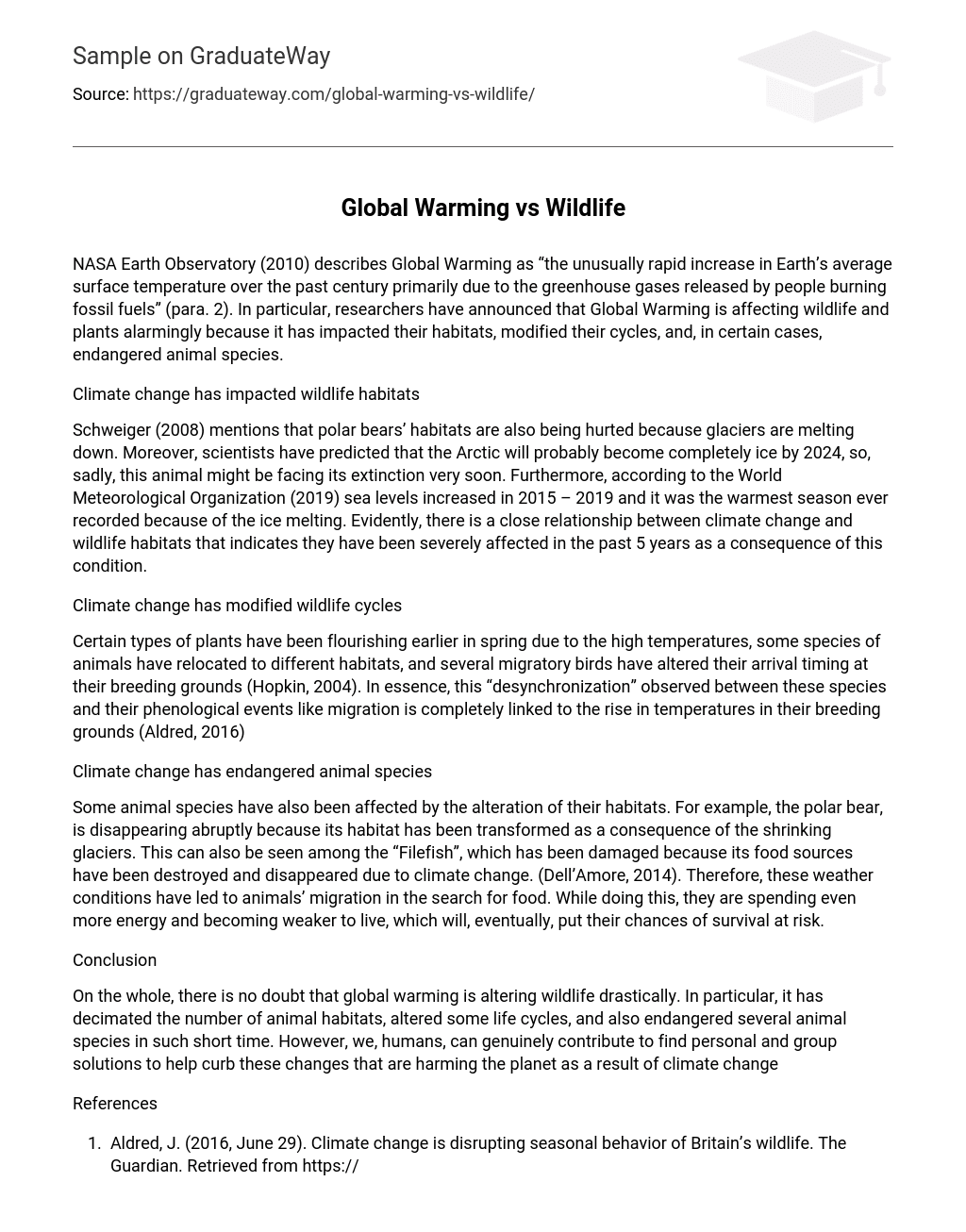NASA Earth Observatory (2010) describes Global Warming as “the unusually rapid increase in Earth’s average surface temperature over the past century primarily due to the greenhouse gases released by people burning fossil fuels” (para. 2). In particular, researchers have announced that Global Warming is affecting wildlife and plants alarmingly because it has impacted their habitats, modified their cycles, and, in certain cases, endangered animal species.
Climate change has impacted wildlife habitats
Schweiger (2008) mentions that polar bears’ habitats are also being hurted because glaciers are melting down. Moreover, scientists have predicted that the Arctic will probably become completely ice by 2024, so, sadly, this animal might be facing its extinction very soon. Furthermore, according to the World Meteorological Organization (2019) sea levels increased in 2015 – 2019 and it was the warmest season ever recorded because of the ice melting. Evidently, there is a close relationship between climate change and wildlife habitats that indicates they have been severely affected in the past 5 years as a consequence of this condition.
Climate change has modified wildlife cycles
Certain types of plants have been flourishing earlier in spring due to the high temperatures, some species of animals have relocated to different habitats, and several migratory birds have altered their arrival timing at their breeding grounds (Hopkin, 2004). In essence, this “desynchronization” observed between these species and their phenological events like migration is completely linked to the rise in temperatures in their breeding grounds (Aldred, 2016)
Climate change has endangered animal species
Some animal species have also been affected by the alteration of their habitats. For example, the polar bear, is disappearing abruptly because its habitat has been transformed as a consequence of the shrinking glaciers. This can also be seen among the “Filefish”, which has been damaged because its food sources have been destroyed and disappeared due to climate change. (Dell’Amore, 2014). Therefore, these weather conditions have led to animals’ migration in the search for food. While doing this, they are spending even more energy and becoming weaker to live, which will, eventually, put their chances of survival at risk.
Conclusion
On the whole, there is no doubt that global warming is altering wildlife drastically. In particular, it has decimated the number of animal habitats, altered some life cycles, and also endangered several animal species in such short time. However, we, humans, can genuinely contribute to find personal and group solutions to help curb these changes that are harming the planet as a result of climate change
References
- Aldred, J. (2016, June 29). Climate change is disrupting seasonal behavior of Britain’s wildlife. The Guardian. Retrieved from https://www.theguardian.com/environment/2016/jun/29/climate-change-is-disrupting-seasonal-behaviour-of-britains-wildlife
- Dell’amore, C. (2014, April 2). 7 Species Hit Hard by Climate Change – Including One that’s
- Already Extinct. National Geographic. Retrieved from
- https://www.nationalgeographic.com/news/2014/4/140331-global-warming-climate-change-ipcc-animals-science-environment/
- Hopkin, M. (2004). Global warming alters US wildlife. Nature. Retrieved from
- https://doi.org/10.1038/news041108-7
- NASA Earth Observatory. (2014). Global Warming. Retrieved from
- https://earthobservatory.nasa.gov/features/GlobalWarming
- Scweiger, L. (2007). Global Warming endangers wildlife. National Wildlife., 45 (3).
- World Meteorological Organization. (2019, September 22). Global Climate in 2015 – 2019: Climate change accelerates. Retrieved from https://public.wmo.int/en/media/press-release/global-climate-2015-2019-climate-change-accelerates





